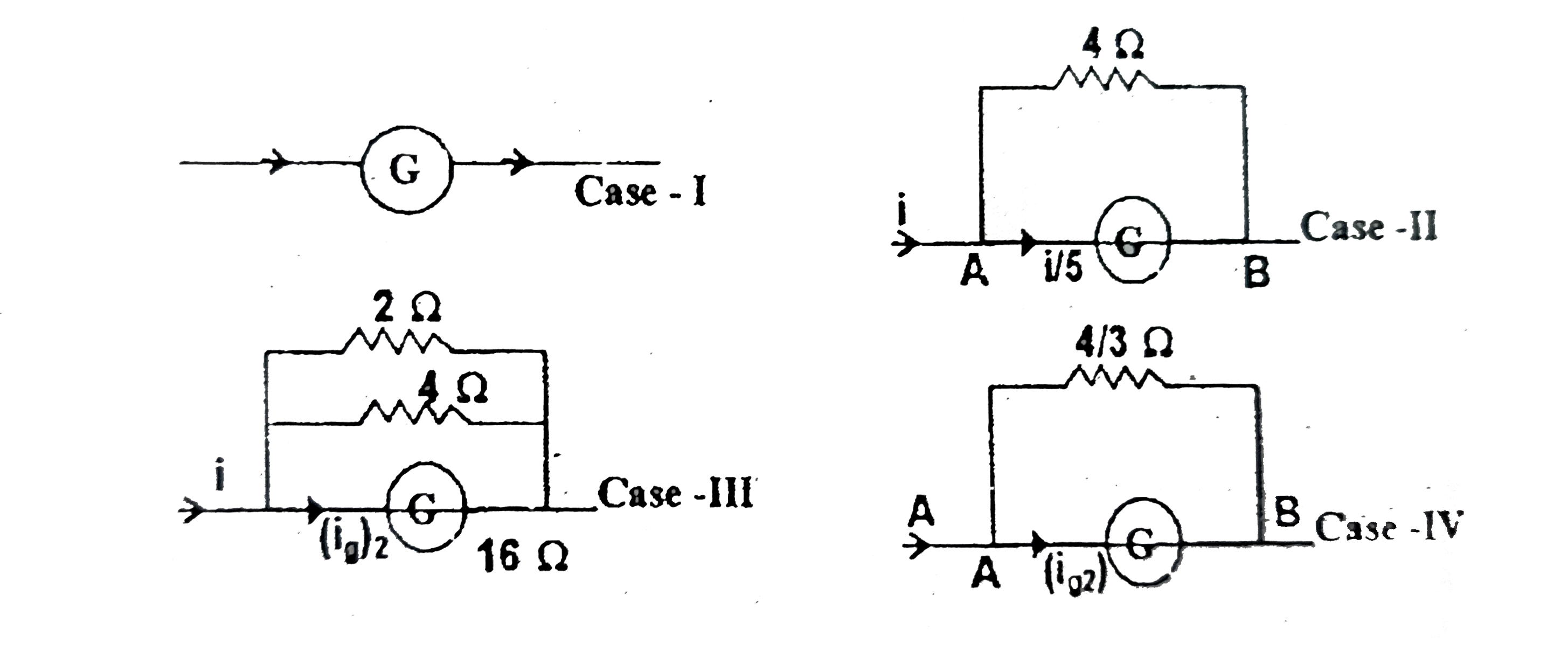When a galvanometer is shunted with a 4Ω resistance the deflection is reduced to1/5. If the galvanometer is further shunted with a 2Ω wire the new deflection will be (assuming the main current remains the same)
5/13 of the deflection when shunted with 4Ω only
8/13 of the deflection when shunted with 4Ω only
3/4 of the deflection when shunted with 4Ω only
3/13 of the deflection when shunted with 4Ω only
When only 4Ω resistance is shunted, (ig), =i/5
G×i/5=4×(4i/5)⇒G=16Ω

(ig)2=4/316+4/3i=113i
Topper's Solved these Questions
- CURRENT ELECTRICITYBook:FIITJEEChapter:CURRENT ELECTRICITYExercise: Illustration
Explore 10 Videos
- CURRENT ELECTRICITYBook:FIITJEEChapter:CURRENT ELECTRICITYExercise:SOLVED PROBLEMS (SUBJECTIVE)
Explore 10 Videos
- COLLISION Book:FIITJEEChapter:COLLISION Exercise:(NUMERICAL BASED QUESTIONS)
Explore 4 Videos
- ELASTICITY AND WAVES Book:FIITJEEChapter:ELASTICITY AND WAVES Exercise:Assignment Problems (Objective) Level-II
Explore 15 Videos
Similar Questions
When a galvanometer is shunted with a 6Ω resistance,the deflection is reduced to one-third.If the galvanometer is further shunted with a resistance of 3Ω the deflection is reduced to
View Solution[" 129.When a galvanometer is shunted with a "6Omega" resistance,the deflection is reduced to one-third.If the "],[" galvanometer is further shunted with a resistance of "3Omega" ,the deflection is reduced to "],[[" (1) one-sixth "," (2) one-fifth "," (3) one-seventh "," (4) two-third "]]
View Solution
Knowledge Check
A galvanometer shows a reading of 0.65 mA. When a galvanometer is shunted with a 4Ω resistance, the deflection is reduced to 0.13 mA if the galvanometer is further shunted with a 2Ω wire, the new reading will be (the main current remains the same)
A0.60mAB0.08mAC0.12mAD0.05mAWhen a galvanometer is shunted with a 4Ω resistance, the deflection is reduced to one-fifth. If the galvanometer is further shunted with a 2Ω wire, determine current in galvanometer now if initially current in galvanometer is I0 (given main current remains same).
AI0/13BI0/5CI0/8D5I0/13When a galvanometer is shunted by 5 Ω resistance, the deflection is reduced to 1"/"6th of the original value. If galvanometer is further shunted with a resistance of 10Ωthe deflection (as measured from original value) will be
Areduce by 120Breduce by 130Creduce by 131Dreduce by 631
[A constant current source as shown in figure is connected across a galvanometer . If galvanometer is shunted by 4Ohm resistance then current in it is reduced to 14th of initial value. If it is further shunted by 2Ω resistance, current is further reduced by ki while original current being same . Find value of k
View SolutionTo measure the resistance of a galvanometer by half deflection method, a shunt is connected to the galvanometer . The shunt is
View SolutionIn a galvanometer, the deflection becomes one half when the galvanometer is shunted by a 20Ω resistance is

View SolutionThe deflection in a M.C.G. is reduced to half , when it is shunted with a 40Ω coil. The resistance of the galvanometer is
View SolutionWhen a moving coil galvanometer is shunted with a resistance of 10Ω,the deflection in the galvanometer reduces from 30 divisions to 6 divisions. The resistance of the galvanometer is
View Solution

